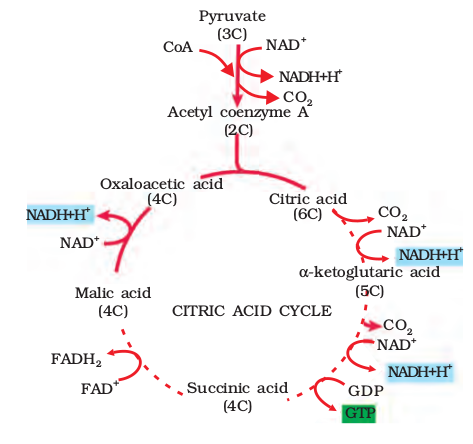The TCA cycle starts with the condensation of acetyl group with oxaloacetic acid (OAA) and water to yield citric acid (Figure 14.3). The reaction is catalysed by the enzyme citrate synthase and a molecule of CoA is released. Citrate is then isomerised to isocitrate. It is followed by two successive steps of decarboxylation, leading to the formation of α-ketoglutaric acid and then succinyl-CoA. In the remaining steps of citric acid cycle, succinyl-CoA is oxidised to OAA allowing the cycle to continue. During the conversion of succinyl-CoA to succinic acid a molecule of GTP is synthesised. This is a substrate level phosphorylation. In a coupled reaction GTP is converted to GDP with the simultaneous synthesis of ATP from ADP. Also there are three points in the cycle where NAD+ is reduced to NADH + H+ and one point where FAD+ is reduced to FADH2. The continued oxidation of acetyl CoA via the TCA cycle requires the continued replenishment of oxaloacetic acid, the first member of the cycle. In addition it also requires regeneration of NAD+ and FAD+ from NADH and FADH2 respectively. The summary equation for this phase of respiration may be written as follows:


We have till now seen that glucose has been broken down to release CO2 and eight molecules of NADH + H+; two of FADH2 have been synthesised besides just two molecules of ATP in TCA cycle. You may be wondering why we have been discussing respiration at all – neither O2 has come into the picture nor the promised large number of ATP has yet been synthesised. Also what is the role of the NADH + H+ and FADH2 that is synthesised? Let us now understand the role of O2 in respiration and how ATP is synthesised.

© 2024 GoodEd Technologies Pvt. Ltd.